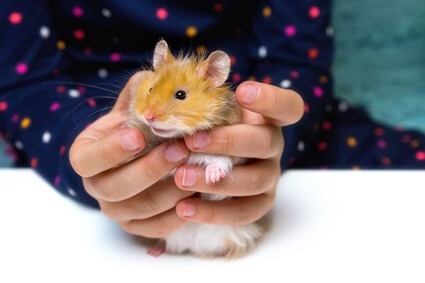Before getting a pet hamster, you must find out how long different species live. Hamsters have short lifespans because they age faster, growing susceptible to health conditions that shorten their lives.
Hamsters live for an average of 2-3 years in captivity. Roborovski hamsters live for 3-3.5 years, while hairless hamsters, which are Syrian hamsters without fur, live for 6-12 months.
Hamsters live short lives because their bodies can’t maintain biological processes like larger mammals. Their cells, tissues, and organisms become less effective as they age.
A healthy diet, enrichment, and reduced stress can maximize a hamster’s longevity.
What Is the Lifespan of a Pet Hamster?
The average lifespan of hamsters in captivity varies based on the species, and life expectancy also depends on the hamster’s health and living environment.
Several factors, like incorrect temperatures and stress, can cause early death. Wild hamsters live shorter lives because they have many predators and must find food that isn’t always available.
The average lifespan across all hamster species is 2 years. Some die younger, while others live longer. Similarly, some species surprise their owners by living beyond their average life expectations.
Hamsters live for 1 human year every 14 days. They age and deteriorate quickly, particularly later in life. The life expectations of each species are as follows:
| Hamster Species | Average Lifespan | Short, Average, or Long |
| Roborovski | 3 to 3.5 years | Long |
| Chinese | 2 to 3 years | Long |
| Syrian | 2 to 2.5 years | Average |
| Campbell’s Dwarf | 2 years | Average |
| Winter White Russian Dwarf | 1.5 to 2 years | Short to average |
| Hairless | 6 months to 1 year | Short |
How Long Do Syrian Hamsters Live?
Syrian hamsters are the most commonly kept pet hamster species. Their slightly larger size and quirky personalities make them popular pets, particularly with families and children.
The average life expectancy of Syrian hamsters is 2 to 2.5 years, although some can live up to 3 years.
Syrians reach maturity when they’re 8-12 weeks old. After this point, they must be separated and kept alone. Syrians are territorial animals and will fight and kill each other in the same cage.
How Long Do Teddy Bear Hamsters Live?
“Teddy bear hamster” describes Syrian hamsters because they look like mini teddy bears. Consequently, their lifespan’s the same at 2 to 2.5 years. They need the following to live long lives:
- A large cage that measures at least 80 x 50 cm (31.5 x 19.5 inches).
- Deep bedding to burrow into, with the highest section measuring 30 cm (12 inches).
- Plenty of hideouts to feel safe and protected.
- Enrichment in the form of toys and chews.
- A healthy diet incorporating lab blocks, seeds, nuts, fruits, vegetables, and occasional insects.
Providing a teddy bear, or Syrian hamster, with these features will maximize its lifespan.
How Long Do Golden Hamsters Live?
Golden hamsters are the same as Syrian hamsters. The former is another nickname from when Syrian hamsters used to have golden-colored fur.
Due to extensive breeding programs, they’re now available in a kaleidoscope of colors – from grey and brown to black and white. Therefore, golden hamsters also have an average lifespan of 2 to 2.5 years – the same as Syrians and teddy bear hamsters.
How Long Do Roborovski Hamsters Live?
Also known as desert hamsters or Robo dwarf hamsters, Roborovski hamsters live in captivity for approximately 3 to 3.5 years. This is slightly longer than their Syrian cousins.
They can live for 4 years or more with the right care and conditions, but this is uncommon.
Despite their lifespans, Roborovskis are the smallest of the most commonly kept captive hamsters. Robos need a more experienced owner than other hamsters because they’re tricky to look after.
Unlike Syrians, you can keep two Robos at once as long as you introduce them from a young age. However, most owners prefer to separate them.
How Long Do Winter White Hamsters Live?
Winter whites have shorter lifespans than most other hamsters. However, they make sweet and loving pets for the short time they’re with us.
Winter white dwarf hamsters live between 1.5 to 2 years on average in captivity. However, they can live up to 3 years if their owners are fortunate. Wild winter whites fare slightly worse, living up to 1 year.
Keeping winter whites as pets is relatively easy as long as you have basic care knowledge.

How Long Do Chinese Hamsters Live?
Chinese hamsters live for 2 to 3 years on average, making them one of the longest-living hamster species. Also, they live longer than other dwarf hamsters.
Chinese hamsters have a mouse-like appearance without a long tail. They’re small and slender, making them popular pets. That said, they’re not as commonly kept as Russian dwarves.
How Long Do Campbell’s Dwarf Hamsters Live?
Campbell’s dwarf Russian hamsters are small animals that live for up to 2 years.
They got their name from Charles William Campbell, the first Westerner to capture one in 1990. Although small, Campbell’s dwarf hamsters are speedy, so they can be difficult to hold.
As a result, accidents can easily occur, especially when small, inexperienced children are involved. However, they can thrive as pets with a healthy, balanced diet.
How Long Do Hairless Hamsters Live?
Hairless hamsters are Syrian hamsters with no fur or whiskers. They have much shorter lifespans than other hamsters and rarely live more than 6 months to a year.
Many breeders and owners are against breeding hairless hamsters because it’s unnatural. They can’t navigate tight spaces like ordinary Syrian hamsters, whose fur helps them slip through.
Hamsters also rely on their fur as a sense of touch due to their poor eyesight.
How To Tell The Age of A Hamster
You can estimate a hamster’s age through its appearance and traits:
Size
Syrian hamsters reach puberty at 6-8 weeks, while dwarf hamsters mature at 8-12 weeks.
Before adulthood, hamsters are much smaller and lighter, weighing about 3 to 3½ oz to 1 oz. If a hamster weighs the same or less, it’s likely a few months old, while a bigger, heavier hamster is older.
Ears
Young hamsters have pink ears that get noticeably darker as they grow older.
Similarly, if a hamster’s ears are shut, it’s less than a week old. However, this is unlikely, as hamsters aren’t ready to leave their mothers until they’re 21-28 days old.
Teeth
While not a definitive way to tell, shorter teeth signify that a hamster’s young rather than old.
PLoS One describes how rodent mandibular incisors, which hamsters have, grow continuously throughout a hamster’s lifetime.
Hamsters’ teeth get longer as they age, even when given wooden toys to chew. This is natural, but ensure they don’t grow too long, as long teeth cause pain.
Fur
Thick, healthy fur that’s an even length indicates that it’s close to or less than a year old. This is considered middle-aged in the hamster world.
Thinning hair signifies a hamster’s getting old. Similarly, if its fur appears greasy or unkempt, it’s likely aging and in the final stages of life.
Eating Habits
Young and middle-aged hamsters should have healthy appetites to fuel their active lifestyles.
Older hamsters naturally lose their appetites, especially when they’re close to the end of their lives. This isn’t a surefire way to determine age, but appetite loss can determine if you have an elderly hamster.
Behavior
Active hamsters are more likely to be aged around a year or younger. Healthy hamsters run on their wheels, burrow, make tunnels, and forage for food, replicating their wild behaviors.
Older hamsters often sleep, coming out periodically for food and water.
Why Do Hamsters Die So Young?
Smaller mammals, like hamsters, age faster than larger animals because their bodies are less effective at maintaining their biological processes.
Aging occurs when organisms, cells, and tissues inside the body become less efficient over time. For example, this causes them to die much sooner than cats and dogs.
Wild hamsters also have shorter lifespans because their bodily resources are allocated to reproduction, meaning they can’t maintain their biological processes like large animals.
Procreation is vital for hamsters because they live in high-risk environments where predation is a daily threat. Reproduction keeps their numbers stable.

How To Make Hamsters Live Longer
While you can’t prevent all illnesses and diseases, you can keep your hamster healthy by providing the best care and ensuring its diet and environment are well-optimized.
Healthy Diet
Hamsters need a healthy, balanced diet to thrive. They’re omnivores, eating a mixture of plants and insects. Replicating their wild diet is the best way to ensure hamsters live long lives.
The ideal diet for hamsters should include the following:
- Commercial pellets – not a muesli-style mix.
- A mixture of different seeds.
- Occasional fresh fruits and vegetables.
- Sprays, such as flax and millet.
- Occasional insects.
- Clean drinking water.
You should also scatter feed a hamster rather than provide food in a dish because this will provide enrichment and encourage natural behaviors.
Provide Physical Enrichment
Hamsters travel up to 6 miles a night in the wild while foraging for food and evading predators.
While it’s tricky for captive hamsters to do the same, providing a large running wheel at least 28 cm in diameter enables your pet to be active, keeping its body strong and healthy.
Other forms of enrichment include the following:
- Cork logs.
- Tunnels.
- Plenty of bedding.
- Different substrates, like sand, corn cob, and coco fiber.
Minimize Stress
Hamsters die from stress and boredom. If they’re not given enough to do in captivity, they develop stereotypies, like bar biting and monkey barring.
According to Applied Animal Behavior Science, hamsters with 80 cm (approximately 31 inches) of bedding never exhibited stress-related behaviors.
Replicating wild conditions is the most effective way to keep a hamster happy.
Monitor For Illnesses
Monitor the hamster for physical or mental changes, which can signify sickness. If you notice any abnormalities with the hamster’s appearance or behavior, take it to the vet for a checkup.
While hamsters don’t live for long, they bring joy to their owners’ lives while they’re with us.





